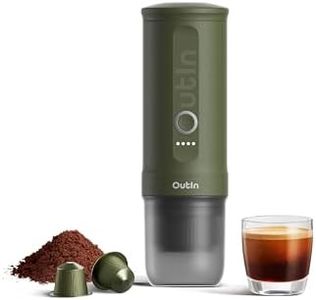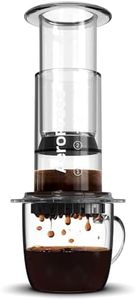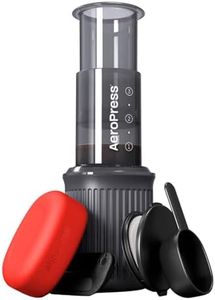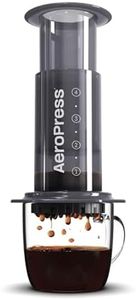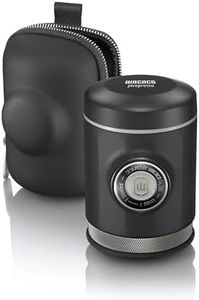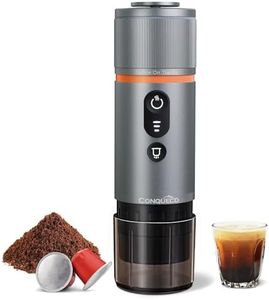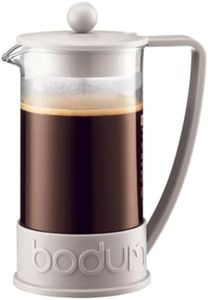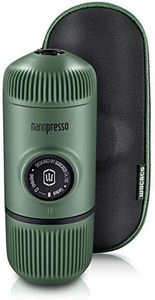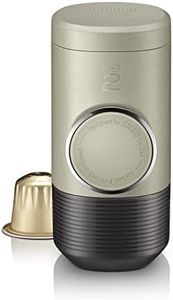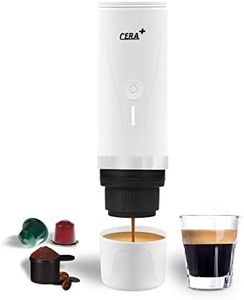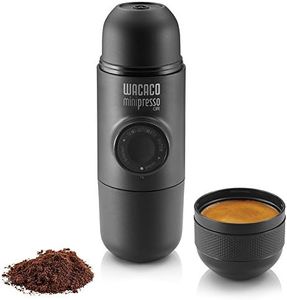We Use CookiesWe use cookies to enhance the security, performance,
functionality and for analytical and promotional activities. By continuing to browse this site you
are agreeing to our privacy policy
10 Best Portable Coffee Maker
From leading brands and best sellers available on the web.Buying Guide for the Best Portable Coffee Maker
Choosing the right portable coffee maker can make your coffee experience more enjoyable wherever you go. The best one for you depends on factors like where you'll use it, what kind of coffee you enjoy, and how much effort you're willing to put into brewing. Start by thinking about your daily routine, the kind of coffee you prefer (such as espresso or drip), and whether you'll use it while camping, commuting, or traveling overseas. With these points in mind, you can focus on the specifications that suit your lifestyle best.Brewing MethodThe brewing method determines how your coffee is made. Common options include manual espresso, French press, pour-over, and single-serve pod brewers. Espresso makers give a strong, concentrated coffee, while French press and pour-over provide a more traditional cup. If you like strong coffee and enjoy experimenting, espresso and French press may appeal to you. If convenience and familiar taste are priorities, go for pod systems or pour-over. Consider where you'll use it: manual methods are great for travel and camping, while pod makers need access to compatible pods.
Size and WeightSize and weight impact how easily you can carry the coffee maker with you. Ultralight and compact models are great for hiking or minimal packing, while slightly larger ones might suit road trips or office use. If you carry limited gear or need to save space, choose a slimmer and lighter model, even if it sacrifices capacity. For those who don't mind a bit more bulk, larger models can provide more features or greater brewing capacity.
Water CapacityWater capacity controls how much coffee you can make at once. Small capacities (under 200ml) are fine for single cups and quick use, while bigger capacities (up to 400ml or more) suit those wanting to brew several cups or share with others. Think about how many people you usually serve and whether you want to brew multiple cups without refilling. Solo travelers or commuters will often be fine with smaller capacities, while group outings may call for something larger.
Power SourcePortable coffee makers can be manual or require electricity or batteries. Manual ones depend on your own effort (like pumping or pressing), which makes them perfect for off-grid situations. Electric versions offer convenience and sometimes built-in heating, but need batteries, USB charging, or a power outlet. If you’ll be outdoors without reliable power, a manual brewer is your best bet. For hotel stays or offices with easy access to power, electric models can save time and effort.
Ease of CleaningThe ease of cleaning matters because simple designs reduce hassle and keep your coffee tasting fresh. Some models are dishwasher-safe or have very few parts to rinse, while others require careful disassembly. If you value speed and simplicity, look for models touted as easy to clean, especially if you anticipate using it daily or while traveling. For users who don’t mind spending a few extra minutes, complex models may offer more features but take a bit longer to maintain.
Build Material and DurabilityBuild material affects durability and taste. Stainless steel and high-quality plastics are common; stainless steel is tough for outdoor use, while BPA-free plastic can keep things light. If you plan on using your coffee maker in challenging conditions or are clumsy, choose tough materials. If low weight or sleek looks are more important, lighter plastics or glass may attract you—but may require more careful handling.
Coffee Grind CompatibilitySome portable coffee makers require a specific grind size to function properly, such as fine espresso grounds or coarser French press grinds. Others may only work with coffee pods. Think about how you’ll get your coffee—do you have access to a grinder, or do you prefer pre-ground coffee or pods? If flexibility is important, pick a maker that can handle various grinds or types; if you’re loyal to a particular brewing style, choose one designed for that specific grind.
